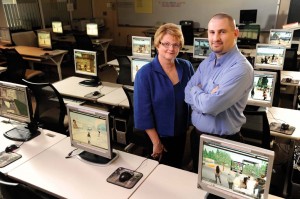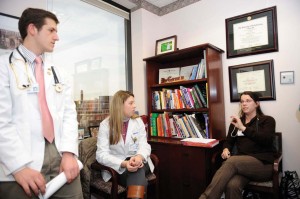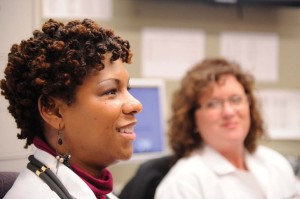by Leslie Hill
Everything in health care is constantly evolving, including how students are taught and faculty are trained. From the virtual world of Second Life to a comprehensive new approach to interprofessional learning, we’re erasing the old chalkboard and rewriting nursing education for the 21st Century.
A New World
The sweatpants-clad nursing student winds her way from the kitchen to the living room, Chinese take-out container in one hand, coffee mug in the other. She settles into the couch, props her feet up on the coffee table and slides her computer onto her lap.
In a parallel realm, she flies skyward, surveying the crystal blue waters surrounding the island that houses Vanderbilt University School of Nursing’s conference center. She then drops through the auditorium ceiling, takes a seat among classmates, and adjusts her camera for a better view of the instructor.
What is this place where nursing students can fly? It’s the world of Second Life, an online virtual reality community, and it’s one of the ways that VUSN is changing how students learn.
Inception
Though Second Life launched in 2003 primarily as a way to socialize, educators quickly realized the learning potential of the virtual world. Instead of projecting art slides against the wall, teachers can lead their class through the Sistine Chapel. They can act out Shakespeare’s comedies and dramas in a replica of the Globe Theater or experience ancient Rome.
Second Life’s inception at VUSN began when Betsy Weiner, PhD, RN-BC, senior associate dean for Informatics, discovered a grant calling for innovative nursing education technologies. She thought back to a recent survey of Tennessee nursing faculty and wondered if Second Life could change the discouraging results.
“The educators were saying they didn’t know how to run a simulation. They said, ‘The computerized mannequins are actually pretty scary and some of us still have them in boxes in the closet. Nobody taught me how to teach when I was in nursing school, and now I’m expected to manage my students,’” Weiner said.
Her solution was to create a master simulation course in Second Life. Faculty would essentially become students and work through a variety of scenarios to become comfortable participating in and leading simulation exercises.
“I had always thought Second Life would be the next big innovative thing because it is so immersive. You can actually walk around and interact with the environment, which makes it more real than a video conference,” Weiner said.
Users create a visual model of themselves (an avatar), much like the setup for video games like Nintendo’s popular wii. The avatar has the ability to walk or fly through the created world. It can speak publically or have private conversations, via text or audio.
Weiner had already attended conferences using Second Life and knew about its convenience – people from all over the world could gather, not after a grueling international plane ride, but from simply logging on from their living room.
VUSN’s Approach
When the $1.6 million grant from Health Resources Services Administration’s Innovative Nurse Education Technologies Program was awarded, the structure of the simulations began to take shape. The focus would be on the geriatric population with 12 scenarios, three each in acute care, outpatient, long-term care and home settings.
But before any role-play could happen, Weiner and her team had to build VUSN’s island, called NurSim4U, literally from the ground up.
“You lease an ‘island’ from Linden Labs, the company that runs Second Life,” explained Ryan McNew, CNE, MCP, senior network manager for the Frist Nursing Informatics Center. “When you get your island, it is just a blank mass of land. From there, you have to build each and every thing you want on your island.”
Any object in Second Life – be it a wall, chair or blood pressure cuff – begins as a “prim” – a primitive shape, like a ball or cube, that is sculpted and molded into the desired object.
Weiner had the idea to replicate actual Vanderbilt buildings on the island, and the team began constructing the Eskind Diabetes Center and an acute care floor from Vanderbilt University Hospital’s Critical Care Tower.

The resemblance is exact – everything from the room configuration down to the carpet and wall colors.
But there have been a few improvements: “One of the providers at Eskind has a view of the back of a building out her current window, so I promised her a better view,” McNew said. Now she looks out at a crystal blue sea.
There are also observation rooms, where users can park their avatar to free up space where the simulation is taking place.
“When you try to do a simulation around a real bed, there is never enough geography and you usually have to assign two or three people to just be observers. The beauty of Second Life is you can sit your avatar far away but adjust your camera to zoom right in on the action,” Weiner said.
They also built a conference center with small rooms where groups could gather and a large auditorium for formal presentations.
Since many faculty are not familiar with gaming, the next step was to create orientation exercises to help users become comfortable inhabiting Second Life. The learning curve is about an hour.
A Video-Game World
“Anybody who has ever played a video game, especially a computer game, understands how to move an avatar,” McNew said. “For adults who have never played, we created a few obstacle courses to teach the basic competencies to be able to get around in Second Life.”
Weiner and her team made another educational innovation to develop the actual scenarios. They turned to Vanderbilt University Medical Center’s Synthetic Derivative, a database of 1.7 million de-identified patient records. Typically only used for research purposes, VUSN is the first to use them for education. It also gives the simulation participants the ability to pull up a full, de-identified medical record while running through the scenario.
Weiner plans to pilot test the simulations in spring, in conjunction with the University of Kentucky College of Nursing, and will market the training to nursing educators in 16 Southern states. She and her team hope to develop a dashboard to help faculty measure their mastery of core competencies.
Next Steps
Though Weiner said there are no immediate plans to have the majority of VUSN students interact in Second Life, she can certainly see the advantage.
“It breaks up the boredom. It’s fun to work with an avatar and it’s something a bit different than regular classes,” she said. “Late at night or early in the morning, people really aren’t all that interested in being shown on a video camera. In Second Life, we can’t see if they’re in their pajamas or haven’t washed their hair.”
Weiner especially sees a future for Informatics majors because classes are typically small. “Instead of using video conferencing, a few Informatics classes have already met a few times in Second Life in a seminar room,” she said.
Second Life offers endless opportunities for role-playing, gathering and learning, and VUSN has just begun exploring its possibilities.
“There needs to be a variety of learning activities that would benefit a nursing student and they’re just not there yet because of the amount of time it takes to build them,” Weiner said. “But the educational potential of Second Life is huge, and we’re excited to be taking these first steps.”
Tearing Down Silos
Compared to the high-tech possibilities of Second Life, interprofessional learning looks remarkably low-tech, but this educational innovation has the potential to exponentially improve how health care is delivered.
Interprofessional education grew from the realization that health care professionals are taught in silos – nursing students learn how to be nurses, pharmacy students learn how to be pharmacists – but when they graduate into a real health care setting, they are expected to work together.
“They get out of school as a great nurse practitioner or pharmacist but they have never had to work in a team delivering care together. They bump into each other, overlap, duplicate, and they don’t understand each other’s capacity,” said Linda Norman, DSN, RN, senior associate dean for Academics. “The practice industry tells us that it takes a long time for new graduates to get used to working in teams, and are asking could we do something about it while they’re in school?”
Vanderbilt’s Approach

The answer to that request is the Vanderbilt University Program in Interprofessional Learning (VPIL), sponsored by a three-year, $600,000 grant from the Josiah Macy Jr. Foundation.
VPIL launched at the beginning of the 2010 school year and brought together 30 students – first-year advanced nurse practitioner students from VUSN, first-year medical students from Vanderbilt School of Medicine, first-year pharmacy students from Lipscomb University and Belmont University, and master’s-level social work students from Tennessee State University.
They are divided into eight teams with one student from each discipline on each team, and they attend a half-day of class and half-day of clinic together each week. The students participate in all aspects of care, from taking history to giving injections – no matter their discipline.
“We don’t deliver care as a single person, and we know that the future of care is going to be delivered in places that have these teams. We want the students to begin learning together from the start of their professional education,” Norman said.
The VPIL experience started with a 10-day immersion period last summer that introduced the students to all the disciplines and helped them get to know the community they would be serving.
Fresh Perspectives
“I’ve never had an experience in a class where students have stayed so consistently engaged,” said Pamela Waynick-Rogers, APN, MSN, who leads the didactic half of VPIL. “There were long days and some of the topics are very emotional, like poverty. They shared and enriched the whole group with their personal experiences of things they’ve seen or done or lived through.”
Early in the immersion, the students broke into groups to talk about their professions, and medical student Andrew Wu said this completely changed his
perceptions.
“I learned what a nurse practitioner actually does. I thought pharmacists stood behind the counter at Walgreen’s; I didn’t know anything about clinical pharmacists. And social work is a completely different realm of care. They are asking questions I never would think of,” he said.

Observing them in the clinics, the teams have an obvious and tight bond, helping and learning from each other. The students also know it is a benefit to interact with patients so early in their education, especially Belmont pharmacy student Jacqueline Allinder.
“This is extra work for me, but I see it as an advantage,” she said. “I’m just studying nitpicky biochemistry and molecular biology, stuff I would never talk to patients about. It’s valuable to be reminded how that actually relates to patients, and now I definitely feel more comfortable around patients.”
Krisa Hoyle has a master’s in Epidemiology and worked in health research for 10 years before returning to VUSN in the family nurse practitioner specialty.
“We have seen so many good examples of how to work together and the dynamics of putting many heads together on an issue,” she said. “I think this is a way to see how we might connect the dots, stop the gaps, put our fingers in the dyke – anything to improve patient care and access to care.”
Maryam Abdallah has worked with the Department of Children’s Services for nine years as a case manager and court liaison and is currently a Child Protective Services Supervisor. Though taking blood pressure and checking ears are a bit out of her realm of expertise, she has appreciated the glimpse into the medical world.
“Many of our referrals at DCS come from hospitals and clinics, so it has been good to see what happens before these children come to us,” she said. “I think we often separate medical problems and social environment, but this program asks us to look at the whole picture.”
Kathy McBane is in the family nurse practitioner program after a business career and 12 years caring for her four children. “I worked in international marketing and was familiar with the collaborative process, so I like that we are taught to be holistic and look at all aspects of learning,” she said.
Faculty Insights
The faculty are also learning how to interact interprofessionally right alongside the students.
“I’m a practicing nurse practitioner, and this has enhanced my personal medical practice by knowing that I can call on pharmacists for more than I traditionally have,” said Shannon Cole, RN, FNP, who leads the clinical half of the program.

Cole has also been impressed with the students’ enthusiasm — an enthusiasm that is contagious.
“I’ve been amazed at what they’re willing to do for our patients outside their already long, four-hour afternoon. Things like finding resources, making phone calls, finding articles of interest. As faculty, it really breathes life into us to see their energy and positive outlook. We remember how we felt at that time, and it makes us want to conquer the world again.”
In the classroom, the VPIL groups work on learning together as a team. The first semester’s curriculum focused on public health and policy, while second semester focused on quality improvement.
Though many schools are beginning to offer interprofessional learning, Vanderbilt is unique in its scope and duration.
“We’ve taken an approach that’s different than anything else we’ve done before and what others have done,” Norman said. “We created a team of students from the different professions who are working together in the clinic over time.”
Instead of a quick weekend seminar or online modules, the VPIL teams will stick together for the length of their educational program. As each member grows in his or her own discipline, the other members will be there to absorb and enhance that knowledge.
Norman and Bonnie Miller, MD, senior associate dean for Health Sciences Education at Vanderbilt School of Medicine, plan to eventually expand VPIL to all entering second-degree nursing students and medical students.
“We’d like to think we’re starting a revolution in the curriculum and more and more schools will be doing this,” she said.
